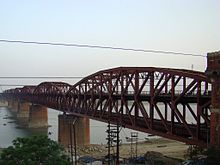
The Godavari Bridge or Kovvur–Rajahmundry Bridge is a truss bridge spanning the Godavari River in Rajahmundry, India. It is India's fourth longest road-cum-rail bridge crossing a water body, the first one being the Bogibeel Bridge, also a rail-cum-road bridge over the Brahmaputra River in the Dibrugarh district of Assam state in north-east India, and second is Digha–Sonpur Bridge over Ganges in Bihar.
Old Walton Bridge is the name given to the first Walton Bridge built across the River Thames between Walton-on-Thames and Shepperton in Surrey, England. The wooden bridge was completed in 1750, was painted by Canaletto and stood until 1783 when, in decay, it was dismantled to make way for a stone-clad brickwork replacement, later painted by J. M. W. Turner.
Captain Walter Napier Thomason Beckett, MVO, DSC was a noted Royal Navy officer in both the First World War and the Second World War. He was known to most people as "Joe" Beckett, after a famous British boxer of the same era, as they shared the same surname. Beckett was also a capable amateur boxer, holding the title of Royal Navy Heavyweight boxing champion for some time.

The East Indian Railway Company, operating as the East Indian Railway, introduced railways to East India and North India, while the Companies such as the Great Indian Peninsula Railway, South Indian Railway, Bombay, Baroda and Central India Railway and the North-Western Railway operated in other parts of India. The company was established on 1 June 1845 in London by a deed of settlement with a capital of £4,000,000, largely raised in London.
The Plaza Bridge in Ottawa, Ontario, Canada, is an automotive and pedestrian bridge that crosses the Rideau Canal just south of the Ottawa locks. It joins Wellington Street and Elgin Street in the Downtown core to the west with Rideau Street to the east. The Chateau Laurier abuts the bridge at the east end, while Parliament Hill is just beyond the west end. It is the northernmost bridge over the canal, just north of the Mackenzie King Bridge.

Varanasi Junction railway station, also known as Varanasi Cantt railway station, is the main railway station serving the city of Varanasi. The other key railway stations in Varanasi Metro area are Banaras, Varanasi City, Kashi and Pandit Deen Dayal Upadhyaya Junction. The junction station is sandwiched between the cantonment region and Chetganj region of the city. The station is partially controlled by the Lucknow Division of the Northern Railway Zone and the Varanasi Division of the North Eastern Railway Zone of the Indian Railways. Varanasi Junction railway station nearly reaches the frequency of 300 trains daily. Almost, 45 trains originate and terminate at the station. Premium trains of Indian Railways also originate from Varanasi Junction, such as Vande Bharat Express and Mahamana Express.

Koilwar Bridge, at Koilwar in Bhojpur spans the Sone river. This 1.44 km long, 2-lane wide rail-cum-road bridge connects Arrah with Patna, the capital of Bihar state in India. The bridge is named after Indian academic and social reformer Prof. Abdul Bari, and is presently the oldest operational railway bridge in India standing since 04 November 1862. It is shown in the 1982 Oscar award winning film Gandhi, directed by Richard Attenborough. From 1862 to 1900, Koilwar bridge remained as the longest river bridge in India.
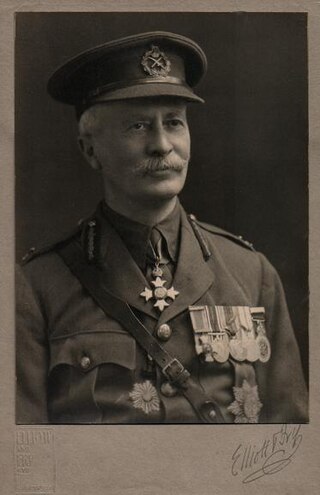
Brigadier-General William Thomas Clifford Beckett CBE DSO VD was a British railway engineer in India and a British Army officer.

The Old Godavari Bridge is a decommissioned bridge that spans the Godavari River in Andhra Pradesh, India. Commissioned in 1900, the bridge served trains plying between Howrah and Madras. It is the earliest of three bridges that span the Godavari River at Rajahmundry. The Godavari Arch Bridge was later constructed as a replacement for the Havelock Bridge. The bridge along with the Godavari bridge and Godavari Arch Bridge is one of the most recognised symbols of Kovvur and Rajahmundry of the state of Andhra Pradesh.

The Godavari Arch Bridge is a bowstring-girder bridge that spans the Godavari River in Rajahmundry, India. It is the latest of the three bridges that span the Godavari river at Rajahmundry. The Havelock Bridge being the earliest, was built in 1897, and having served its full utility, was decommissioned in 1997. The second bridge known as the Godavari Bridge is a truss bridge and is India's third longest road-cum-rail bridge crossing a water body.
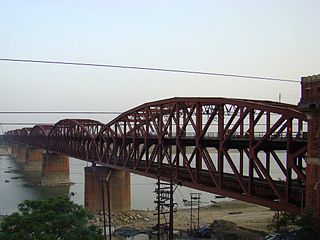
Malviya Bridge, inaugurated in 1887, is a double decker bridge over the Ganges at Varanasi. It carries rail track on lower deck and road on the upper deck. It is one of the major bridges on the Ganges and carries the Grand Trunk Road across the river.
Azimganj Junction is a railway station on the Barharwa–Azimganj–Katwa loop and is located in Murshidabad district lying west of Bhagirathi, a part of the Hooghly river in the Indian state of West Bengal. It serves Jiaganj Azimganj municipality.
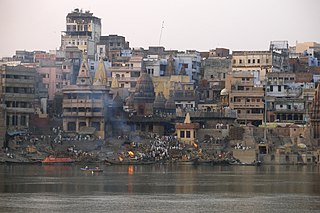
Varanasi is a city on the Ganges river in northern India that has a central place in the traditions of pilgrimage, death, and mourning in the Hindu world. The city has a syncretic tradition of Muslim artisanship that underpins its religious tourism. Located in the middle-Ganges valley in the southeastern part of the state of Uttar Pradesh, Varanasi lies on the left bank of the river. It is 692 kilometres (430 mi) to the southeast of India's capital New Delhi and 320 kilometres (200 mi) to the southeast of the state capital, Lucknow. It lies 121 kilometres (75 mi) downstream of Prayagraj, where the confluence with the Yamuna river is another major Hindu pilgrimage site.
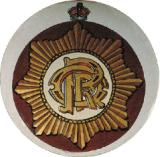
Oudh and Rohilkhand Railway was an extensive railway network in the North India, mostly north of the Ganges, starting from Benares and subsequently up to Delhi.

The Pandit Deen Dayal Upadhyaya Junction – Kanpur section, formerly Mughalsarai–Kanpur section, officially Kanpur - Pt. Deen Dayal Upadhyay (CNB-DDU) section, is a railway line connecting Pandit Deen Dayal Upadhyaya Junction (DDU) and Kanpur Central (CNB) stations. This 347 km (216 mi) track is part of the Howrah–Delhi main line and Howrah–Gaya–Delhi line. The main line is under the jurisdiction of North Central Railway. Pandit Deen Dayal Upadhyaya Junction is under the jurisdiction of East Central Railway. Some branch lines are under the jurisdiction of the North Eastern Railway and Northern Railway.

Aligarh Junction railway station is an 'A' class junction station on the Kanpur–Delhi section of Howrah–Delhi main line and Howrah–Gaya–Delhi line. It is located in Aligarh district in the Indian state of Uttar Pradesh. It serves Aligarh.
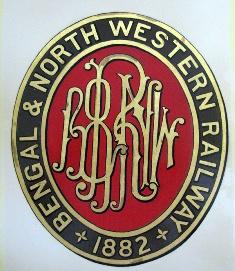
The Bengal and North Western Railway was owned and worked by the Bengal and North Western Railway Company. The Bengal and North Western Railway was merged into the Oudh and Tirhut Railway on 1 January 1943.
Cawnpore–Barabanki Railway (C–B) (1943-1953) (earlier called Cawnpore–Burhwal Railway was a railway in northern India. It was managed as part of the East Indian Railway, and was worked by the Bengal and North Western Railway and the Rohilkund and Kumaon Railway.

The Varanasi–Ayodhya–Lucknow line is a railway line connecting Varanasi and Lucknow, both in the Indian state of Uttar Pradesh. The main line was subsequently extended to Bareilly, Moradabad and Saharanpur and the entire line was thought of as the "main line" of Oudh and Rohilkhand Railway. An important branch line, the Prayagraj–Ayodhya line, which meets the main line almost at right angles, is included here. The main line is under the administrative jurisdiction of Northern Railway, a portion of the branch line is under the jurisdiction of North Central Railway.

The Oudh State was a Mughal subah, then an independent kingdom, and lastly a princely state in the Awadh region of North India until its annexation by the British in 1856. The name Oudh, now obsolete, was once the anglicized name of the state, also written historically as Oudhe.
